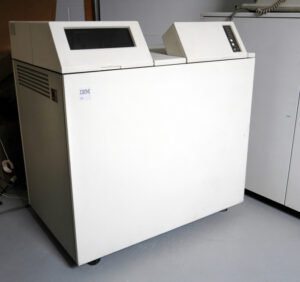 Developing, maintaining and supporting Information Technology (IT) systems for an organisation the size of Donegal Education and Training Board (ETB), which is dispersed right across the county and its islands is no mean feat. As our first ever Head of IT, Ciaran Cunningham, retires in December, in this blog he reflects on how he developed our systems over the last (almost) forty years.
Developing, maintaining and supporting Information Technology (IT) systems for an organisation the size of Donegal Education and Training Board (ETB), which is dispersed right across the county and its islands is no mean feat. As our first ever Head of IT, Ciaran Cunningham, retires in December, in this blog he reflects on how he developed our systems over the last (almost) forty years.
On my first day working with Donegal Vocational Education Committee (VEC), as we were previously called, in December 1986, I was introduced to the recently acquired IBM System/36. This large microcomputer was purchased to run our Payroll and Finance systems. Prior to this, payroll was processed on a Memorex system in which the user fed pay cards with magnetic strips. The inputted data was captured on a cassette tape to be replayed later producing pay orders and various reports.

The IBM computer was the size of a small dining table with 2mb of Ram, a 40mb hard disk and it swallowed 8” floppy disks on backups. That may sound like a technical beast, but its processing power wouldn’t come near a modern-day smartwatch. It had three green-screen dumb terminals and only two main tasks which it did for many years without fail.
The introduction of a computerised finance system would greatly facilitate and expedite the various processes. Salary payments were still issued by pay order which still had to be packed in envelopes and posted out. Donegal VEC processed payroll and paid suppliers for its, at the time, eleven schools, the Regional Technical College in Letterkenny, now part of the ATU, Gartan Outdoor Education and Training Centre and the Tourism College in Killybegs (also now part of ATU).
Personal computers would not become widely available until a few years later. There was only one in the VEC office, which sat quietly in the corner of the Human Resources (HR) manager with its dust cover permanently on.
Donegal VEC worked as part of a wider User Group of VECs, which included Dublin, Cork, Limerick and Waterford, to develop software systems. This group proved hugely beneficial and Donegal led the way in developing many of the systems still used today by Shared Services including CoreHR, SunSystems and P2P.
The VEC finally got connected to the internet in 1994. We had just purchased a 28.8k modem to facilitate the transfer of staff pay electronically to their nominated bank accounts using Paypath. The World Wide Web was in its infancy but in May 2000 I designed and published Donegal VEC’s first website. Having an online presence, even with this very slow connection, allowed the VEC to begin promoting their services, updates and any vacancies.
One of the links on that first website was our Statement of Year 2000 Compliance. The Y2K (Year 2000) bug as it was known, presented one of the first major IT challenges to an organisation like ours. The IBM system had year dates coded in two digits only. This could have caused a major issue as the world welcomed in the new millennium. It was feared that computer systems where would get confused when interpreting system dates. ‘00’ might be interpreted as 1900 instead of 2000, hence the bug’s name. There was real fear around the world that computer systems could fail. Aeroplanes would fall from the sky and nuclear war could be triggered accidentally as New Year’s Eve rang in. Thankfully Donegal VEC was on the ball and the world was in safe hands. We, in conjunction with the User Group, had been preparing for this for most of the previous year so the date passed without any major issue.
With the phenomenal growth of the internet, email soon became the predominant form of communication. At this time, Donegal VEC did not have an IT Department. I was the Head of Payroll with a responsibility for IT. Having no technical support in-house, I decided to roll out a new online platform called Google Apps in 2007 which was still in Beta mode. This negated the need to manage a Microsoft Exchange Server for email. It also allowed us to move our data storage to the Cloud. Documents, spreadsheets and presentations could all now be worked on anywhere with internet connection. This facilitated staff to work from home and collaborate if required. We also rolled out Google Classroom to our schools which facilitated online learning. This was a real game changer and allowed teachers to communicate and educate their students in a virtual classroom. A number of years later when COVID-19 struck, Donegal ETB hit the ground running. I was proud that our schools and centres were ready to teach online and our payroll staff were able to process payments working remotely in the first week of Lockdown.
2007 also saw the first steps in building our own IT support team when Richard Vaughan joined. Over the following years, we have slowly built up a small but excellent and professional team. Since then, we have rolled out Enterprise Wi-Fi to all our schools and centres. Connectivity had always been a huge challenge in a large, dispersed county like Donegal. We manage our own IT Helpdesk and provide support remotely, if possible, with site visits when appropriate. Enterprise Wi-Fi gave all our staff and students high-speed access to the internet while also effectively creating a wide area network where our technical support team could drop into any PC in any of our schools and centres to fix basic issues.
In the early days, an IT department had to guard against rogue floppy disks and USB sticks which may carry a virus to be triggered on startup. In recent years the threat has become much more invasive and difficult to counter with systems being online all the time. A recent test on a freshly installed Windows 95 PC without protection found the device to be totally compromised within just ten minutes of connecting to the internet for the first time.
Today, all our main systems are hosted in the Cloud, which simply means they are on managed servers in another location, and we access via the internet. Our main Financial and HR systems are now hosted and managed by the Education Shared Business Services (ESBS) Centre. Our email is still hosted on Google, but we also have a domain on Office 365. Donegal ETB has recently invested heavily in the Microsoft platform so that we can comply with audit requirements. We intend to retain the Google platform to facilitate our student network.
Donegal ETB has implemented advanced security measures including 2 Step Verification for all staff, SOC/SEIM, phishing campaigns and additional virus and malware protective measures. We have recently engaged with a third-party security firm to analyse our systems to identify any weaknesses in preparation for an upcoming ICT Baseline audit.
Our IT team has invested a huge amount of time and effort on building our cyber defence, but as always, our first and greatest line of defence is our employees. The widely publicised attack in May 2021 on the HSE, was a real wake-up call for every organisation as it highlighted the need for all public bodies to bolster their cyber defences. It took just one user in the HSE to click on one link, without thinking, to bring their whole organisation to its knees.
If we are to continue to stay safe, we all need to be more vigilant. It is no longer a valid excuse to say ‘I don’t know much about computers.’ Nearly every interaction, be it with Public Services or our social interactions, require us to be online using our smartphones or computers. Staying safe online will require us all to remain on our digital toes.
Donegal ETB has come a long way in my 38 years here. We now use technologies we could not have imagined back then. We also face greater challenges than ever before.
Artificial Intelligence (AI) will bring exponential positive developments in many areas including Healthcare, but it will also raise the level of risk way beyond what we have now. We all need to learn to Stop and Think, before we Click. Education has a huge role to play in keeping us all safe online. I believe Donegal ETB can and must lead the way in this area by promoting online safety amongst all our staff and students.
